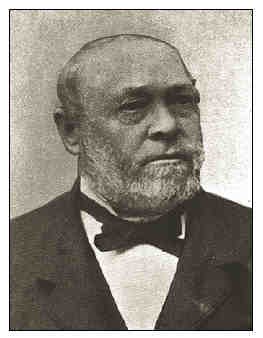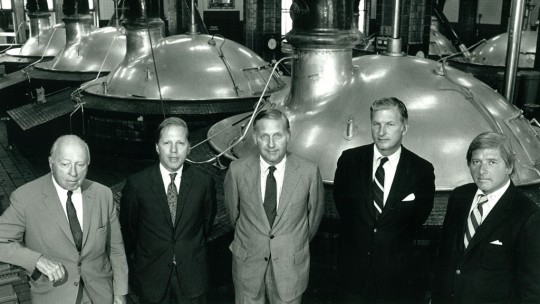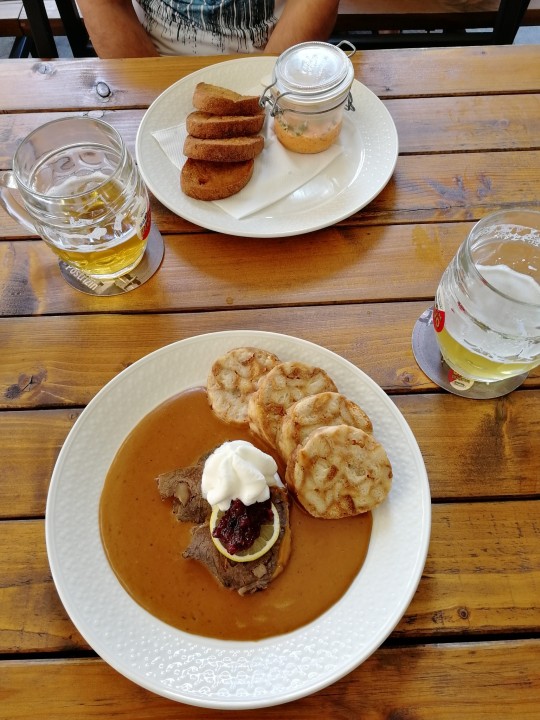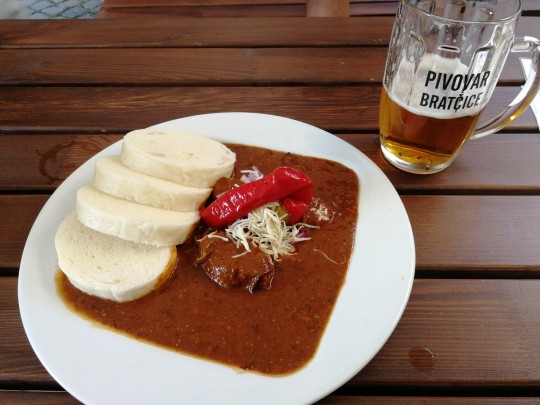#Bohemian Pilsner
Explore tagged Tumblr posts
Text
South Moravian landscape near Kyjov, Czech Republic
© Tomas Vocelka
500px
The Carpathian Mountains tower over the east, and the Bohemian-Moravian Highlands rise in the northwest, cradling the farming valleys of the South Moravian Region of the Czech Republic. And though you may think of pilsner beer when you think of the Czech Republic, this is wine country. The vineyards of South Moravia yield most of the country’s wine.

#Tomas Vocelka#500px#South Moravian landscape near Kyjov#czech republic#The Carpathian Mountains tower#the Bohemian-Moravian Highlands rise#South Moravian Region#The vineyards of South Moravia#the country’s wine#artists photographie#art#original art#original photographer#photographer#art style#art gallery#colors nature#paisatge#art colors#black and white photography#nature photos#art photography#urban photography#color photography#aesthetic photography#nature photography#de tot#fotos art#xpuigc#xpuigc bloc
10 notes
·
View notes
Text

21 Facts about the 𝗖𝘇𝗲𝗰𝗵 𝗥𝗲𝗽𝘂𝗯𝗹𝗶𝗰:
1. The Czech Republic was formed in 1993, following the peaceful split of Czechoslovakia in what is known as the Velvet Divorce.
2. The country is home to over 2,000 castles, making it one of the highest densities of castles in the world.
3. Prague, the capital city, is home to the largest ancient castle in the world, Prague Castle, according to the Guinness Book of World Records.
4. The Czech Republic is the birthplace of the world-famous Pilsner lager, originating from the city of Plzeň (Pilsen) in 1842.
5. The country has a long tradition of puppetry and marionette exhibitions. Puppetry was added to UNESCO's list of Intangible Cultural Heritage in 2016.
6. The Gregor Mendel, the founder of genetics, was born in 1822 in what is now the Czech Republic.
7. The Czech Republic ranks as one of the top countries in terms of beer consumption per capita. The tradition of brewing dates back to the 10th century.
8. The currency used is the Czech koruna (CZK), as the country has not adopted the Euro.
9. The Charles University in Prague, established in 1348, is one of the oldest universities in the world.
10. The traditional Christmas dinner in the Czech Republic often includes carp, which families sometimes keep alive in their bathtubs before preparing it for the meal.
11. The Czech Republic is the birthplace of the renowned Art Nouveau artist Alphonse Mucha.
12. The country's landscape is quite diverse, including bohemian paradise's rock cities, Moravian karst caves, and mountain ranges like the Krkonoše, home to the highest peak in the country, Sněžka.
13. The Czech Republic is known for its spa towns, including Karlovy Vary, Mariánské Lázně, and Františkovy Lázně, attracting visitors seeking relaxation and therapeutic treatments.
14. The Moravian Karst, a protected nature reserve in the eastern part of the Czech Republic, features more than 1,000 known caves and gorges.
15. The Velocipedes Museum in Česká Třebová is one of the world's largest museums dedicated to bicycles and motorcycles.
16. The Czech language belongs to the West Slavic group of languages and is known for its challenging pronunciation and grammar.
17. Traditional Czech glassmaking and crystal production have a long history, with Bohemian crystal being highly prized worldwide.
18. The Olomouc cheese, known as Olomoucké syrečky or tvarůžky, is a smelly, aged cheese from the region of Olomouc, famous throughout the country.
19. The Czech Republic has a significant tradition of animation and film, with filmmakers like Jan Švankmajer gaining international acclaim.
20. Kutná Hora, a town in the Czech Republic, is home to the Sedlec Ossuary, a small Roman Catholic chapel, adorned with decorations made out of human bones.
21. The Czech Republic was the first former Eastern Bloc state to gain developed economy status according to the World Bank, showcasing its successful transition from a state-controlled economy to a market-driven one.
#czech republic#ancestors alive!#what is remembered lives#memory & spirit of place#ancient ways#sacred ways#folkways#traditions
2 notes
·
View notes
Text

Forgot all about this in my drafts. Frank's 80/20 Brewery. Pretty sure I've seen this at a second location, but the other big drink menu seems more common.
Transcript under cut:
Tap List ABV IBU Price 10% 150 Zigzagger (Triple Hopped double !PA) 20 3.5% 52 Stout Crusader (Sweet Stout) 18 8.2% 94.8 Bitter sweet (Imperial IPA) 19 7.6% 656 Message in a bottle (Black IPA) 18 7.0% 56 Pujas (India Pale Ale) 17 6.5% 50 Half wit (Hop wheat) 16 6.1% 16.9 *Kabunyan (American wheat beer) 16 6.1% 21.52 Rolling fog (German wheat beer) 17 6.1% *Lagnd (Fruit beer) 17 6.2% 25 Doug's Flying Amber (American amber ale) 18 6.0% 90.12 *Black Sparrow (Dark wheat ale) 17 6.6% 18.59 Old xavier 56 (Bohemian pilsner) 20 5.5% 24 *Extintor de sed (Mexican lager) 20 5.2% 19 *Orlys Dunkelweizen (Dark wheat ale) 17 6.3% 26.56 Kraken (Baltic Porter) 17
Also avaliable: six pack sample ---> P330
2 notes
·
View notes
Text

Strohs Brewery 991 Gratiot Ave
Stroh Brewing Company started with Johann Peter Stroh in 1775 in Kirn, Germany. Johann and his family lived in a house with an adjoining brew house attached, and ran a local inn that served meals and their family’s recipe for Bohemian-style Pilsner Ale. Johann had three sons and one daughter. His second son, Georg Freidrich Stroh, inherited the brew house. Georg’s youngest son was
Johann Bernhard Stroh (known to the world as Bernhard), who was born in 1821. On February 22, 1848, revolutions erupted across Europe. With all the turbulent violence surrounding Europe in the mid-19th century, and with his father Johann’s death and his elder brother Georg inheriting the family business, a 27 year old Bernhard Stroh, who had learned the brewing trade, immigrated to the United States.

Bernhard Stroh arrived in the United States in 1850. He immediately started his own business. Stroh opened a brewery at 57 Catherine Street…He developed a market for a new light lager beer among the larger German immigrant population, and names his new company Lion’s Head Brewery, adopting the Lion’s Crest logo from Kyrburg Castle in Kirn, Germany.
The company uses this same crest as their logo to this day. With only an investment of $150 (in 2016 dollars, this would amount to $4,409.53) that he provided himself through working for the family inn back in Germany, Stroh had to be very frugal in his spending. By 1860, Stroh’s customers had a desire for Stroh to start bottling his famous beer so they could enjoy the Bohemian-style Pilsner Ale at their homes.

Bernhard Stroh would have his sons personally cart small kegs of beer to his customer’s homes and business by wheelbarrow.
Stroh’s would not only become Detroit’s largest brewer, but the third largest in the country.
This massive, million-square-foot factory at Gratiot near I-75 grew as the company did, with buildings dating from the 1860s to 1914. In late 1890, the firm Spier & Rohns was hired to make extensive additions and improvements to the Stroh campus, including building a 25-foot-by-70-foot fireproof stockhouse, a 60-foot-by-100-foot bottling works, and a new ice-machine plant. These additions made the brewery the largest in Michigan and formed some of the most visible parts of the plant.
By 1956, the Detroit brewery was pumping out 2.7 million barrels of beer — 83.7 million gallons.
he 1970s and 1980s were very productive years for the Stroh’s; sales continued to increase with the acquisition of Goebel’s, new leadership came in 1967 with John Stroh becoming CEO and Peter Stroh, Gari Stroh’s son, became President. The duo expanded the company to its greatest height throughout the two decades with new marketing and aggressive advertising strategies. With increased sales, the Stroh brewing company was able to match the big three car companies in terms of salaries and benefits. Early in the 1980’s, Peter Stroh started looking to take Stroh’s to the national stage, and made a bid on the Schaeffer Brewing Company and Schlitz Brewing Company. Schaeffer started to go into debt in the late 1970s and early ’80s, making the buyout from Stroh’s all too easy in 1981. Schlitz accepted a buyout offer of $17 a share. Schlitz became a wholly owned subsidiary of the Stroh Brewing Company, making Stroh the third-largest brewery in the United States. With all this expansion, Peter Stroh, now CEO at this time, realized his company was overextended. By 1985, Peter Stroh recognized his company was operating with excess capacity, On Feb. 8, 1985, Stroh’s announced it was closing its Detroit facility, calling it too costly to run and too inefficient compared with newer facilities it had acquired. The plant was shuttered that May, bringing an end to 135 years of tradition and costing 1,159 Detroiters their jobs.

The factory was imploded in two phases -- on April 13, 1986, and July 13, 1986 -- with the land soon redeveloped as Brewery Park.
In 1999, the struggling company was imploded, too, split up and sold to Miller Brewing and Pabst.
2 notes
·
View notes
Text
Czechia: A Fairy-Tale Destination for Couples, Hikers, and Curious Travelers 🇨🇿

Nestled in the heart of Europe, Czechia (the Czech Republic) is a land where medieval castles pierce moody skies, cobblestone streets whisper stories of centuries past, and rolling green landscapes invite endless exploration. Whether you’re a couple seeking romance, a hiker chasing trails, or simply a traveler craving authenticity, Czechia delivers magic at every turn—and without emptying your wallet. Ready to plan your adventure? Trip.com makes it easy with unbeatable deals on flights, hotels, and curated experiences. Let’s dive into why this Central European gem should be your next destination!

Prague: The Crown Jewel of Romance
No visit to Czechia is complete without losing yourself in Prague , a city that feels like it leapt from the pages of a fairy tale. Stroll hand-in-hand across the Charles Bridge at sunrise, where statues of saints line the path and views of Prague Castle shimmer across the Vltava River. Wander through Old Town Square , home to the hourly spectacle of the Astronomical Clock and cozy cafés serving rich hot chocolate. For panoramic vistas, hike or take a tram to Prague Castle , the largest ancient castle complex in the world.
Pro Tip : Book a boutique hotel in the Lesser Town (Lesser Újezd) district via Trip.com for easy access to Prague’s top sights—and budget-friendly prices.

Beyond Prague: Hidden Gems for Every Traveler
While Prague dazzles, Czechia’s charm extends far beyond its capital.
Český Krumlov : A UNESCO-listed town with a storybook castle, winding river cruises, and cobblestone alleys that feel frozen in time. Perfect for couples and photographers!
Karlovy Vary : This spa town, famous for its healing thermal springs, offers elegant colonnades, scenic hiking trails, and a romantic atmosphere.
Brno : Czechia’s second-largest city blends Gothic architecture with vibrant street art, craft beer bars, and nearby wine regions.
Use Trip.com to book train tickets and multi-city packages, making it effortless to explore these gems.

Hiking Heaven: Trails for Every Skill Level
Czechia’s diverse landscapes are a hiker’s paradise. From forested mountains to dramatic rock formations, lace up your boots and hit the trails:
Bohemian Switzerland National Park : Home to the iconic Devil’s Bridge (Čertov Most) , a natural rock arch carved by time. The park’s sandstone cliffs and dense forests are ideal for day hikes.
Šumava Mountains : Trek through alpine meadows, glacial lakes, and ancient beech forests. Don’t miss the Plauen Glass Forest , a surreal trail lined with hanging glass sculptures.
Moravian Karst : Explore underground caves like Macocha Abyss , then hike above ground through lush valleys and vineyards.
Trip.com partners with local guides to offer affordable hiking tours, gear rentals, and eco-lodges near trailheads.
Why Czechia Wins: Affordable Luxury, Rich Culture
Czechia’s biggest allure? It offers European elegance without the sticker shock. Savor gourmet meals, historic hotels, and spa treatments at a fraction of Western Europe’s prices. Try trdelník (a sweet pastry) by a castle, sip Pilsner Urquell (the original pilsner) in a centuries-old pub, or unwind in Karlovy Vary’s thermal springs.
Seasonal events like Prague’s Christmas Markets and summer Smetana’s Litomyšl Opera Festival add to the country’s vibrant tapestry.
Plan Your Czechia Escape with Trip.com
Whether you’re craving a romantic getaway, an active hiking adventure, or a mix of both, Trip.com has you covered:
Flights : Find cheap round-trip flights to Prague (PRG) from major cities.
Hotels : Choose from budget hostels to spa resorts in Karlovy Vary.
Tours : Book guided hikes, castle visits, or beer-tasting experiences.
Deals : Snag flash sales on last-minute packages!
Ready to Fall for Czechia?
From Prague’s golden spires to Bohemia’s wild landscapes, Czechia is a destination that surprises and enchants. Let Trip.com handle the logistics while you create memories that’ll last a lifetime. Skål to adventure! 🍻
This article contains affiliate links. Using Trip.com helps support our content at no extra cost to you.
#czech republic travel#Czechia tourism#Romantic#travel destinations#hiking in albania#czech republic#affordablehourlylimoservice#Europe trips
0 notes
Text
Episode 587 - Czech Light Lagers
The lighter beers produced in the Czech Republic have inspired a bevy of lighter lagers stateside, so we get as Bohemian as we can with five different beers – four from the Chicagoland area. We brush up on our definitions of Czech pilsners and Czech pale lagers while finding some surprising local examples. Plus, we’re getting sucked into game ads due to some hazy bait, we make a pitch to fund our…
0 notes
Text
youtube
Top 10 Most Beautiful Places to Visit in Czech Republic | Breathtaking Destinations | Life Travel
https://expedia.com/affiliate/7UOXNXE
https://airalo.tp.st/UYXhV3Jr
http://knowledgeglaxy.com/travels/
Description:
Discover the most beautiful destinations in the Czech Republic! From the charming streets of Prague to fairy-tale castles, breathtaking nature, and historic towns, this list showcases must-visit places in one of Europe’s most stunning countries.
🌍 Places Featured: 1️⃣ Prague – Charles Bridge, Astronomical Clock & Prague Castle 2️⃣ Český Krumlov – A fairy-tale town with a stunning castle 3️⃣ Karlovy Vary – A famous spa town with colorful architecture 4️⃣ Kutná Hora – Home to the unique Sedlec Ossuary (Bone Church) 5️⃣ Bohemian Switzerland National Park – Incredible rock formations & landscapes 6️⃣ Telč – A picturesque town with pastel-colored Renaissance houses 7️⃣ Pilsen – The birthplace of the world-famous Pilsner beer 8️⃣ Moravian Karst – Stunning caves and natural rock formations 9️⃣ Olomouc – A historic city with baroque fountains & a UNESCO-listed column 🔟 Adršpach-Teplice Rocks – Unique rock formations and breathtaking trails
✈️ Plan your Czech adventure and experience its rich history, culture, and natural beauty!
🔔 Don’t forget to Like, Comment & Subscribe for more travel inspiration!
#CzechRepublic#Travel#Prague#VisitCzechRepublic#BucketList#FairyTaleDestinations#EuropeTravel#HiddenGems#Tourism#Adventure#Youtube
1 note
·
View note
Text
🌍 Bohemian Rhapsody A Journey Through Czech History & Culture

Thinking about your next big adventure? ✈️ Let me introduce you to the Czech Republic – the heart of Europe that deserves a top spot on your travel bucket list. Whether you're planning to search for that perfect Europe family trip package, this country has something magical for everyone. 💫
🏰 Step Into History Picture this: wandering through cobblestone streets in Prague, exploring the majestic Prague Castle, or standing in awe at Kutná Hora’s hauntingly beautiful Bone Church. This place is a living, breathing time machine that takes you through Gothic, Baroque, and medieval marvels in every corner.
🍻 Food & Drinks That Warm Your Soul Czech cuisine is all about comfort. Goulash, dumplings, trdelník (that sweet spiral pastry!), and the BEST beer you’ll ever taste – trust me, this is foodie heaven! Did you know the Czech Republic is the birthplace of Pilsner beer? Time to toast to that! 🍺
🌄 Nature Lovers, Rejoice! Bohemian Switzerland National Park is straight out of a fantasy novel, with towering sandstone arches and dreamy forests. And if vineyards are more your vibe, the rolling hills of Moravia will have you sipping on wine with a side of breathtaking views. 🍇✨
🎡 Why It’s Perfect for Indian Travelers The Czech Republic is affordable, easy to explore, and oh-so-stunning. Plus, Prague’s got amazing Indian restaurants when you start craving a taste of home. 🌶️
So, whether you're exploring travel for the first time or adding it to your Europe tour package lineup, the Czech Republic is the fairy tale destination you didn’t know you needed. 🌟
Pack your bags, grab your camera, and get ready for a trip that’ll feel like stepping into another world. 🌍❤️
0 notes
Text
Day One Distribution and Chuckanut Brewery enter distribution agreement to put more beer into Oregon.
https://bit.ly/40wZqiM Portland, OR … Specialty craft beer distributor Day One Distribution is excited to announce the first ever release of Chuckanut Brewery’s flagship Bohemian-style Pilsner Lager and Kölsch German-style Ale in the 12oz six-pack format in Oregon. … Over the past 3.5 years, Chuckanut – an award-winning brewery focused on traditional European-style Lagers and Ales based in Burlington, Washington has been hard at work expanding the footprint of their production facility and taproom located adjacent to the Port of Skagit. While their original brewery & taproom in Bellingham closed in 2021 and the Portland P-Nut taproom both opened and closed over that same timeframe, they’ve also been simultaneously focused on doubling the size of their production space to keep up with increasing demand for draft, but to also bring online a new, state-of-the-art canning line. “Our canning line is up and running and we are sending out cans to all our distributors in the North, Greater Seattle region, and to Oregon,” exclaimed Chuckanut co-owner Mari Kemper. “Yes, we are starting with Kölsch and Pilsner then we’ll move on to our seasonals – Japanese Style Lager in winter, Mexican Style Lager in spring, and Fest Bier in fall.” Their new canning line arrived in Burlington in December and they’ve been hard at work dialing everything in to enable their first canning runs to start off the new year. Just today, Day One Distribution received not only an abundance of Chuckanut’s Pilsner and Kölsch cases in cans, but also a variety of seasonal kegs including Vienna Lager, Export Stout, Citra Leaf Pilsner, Rye Lager, and Dunkel Lager. “The prospect of a new canning line on the horizon, announced as part of their expansion a few years back, was very welcome news throughout the beer community in Portland,” says Day One founder Robby Roda. “Previous to today, their Portland taproom was the only place one could fine Chuckanut in the 12oz can format, but now it’ll be available everywhere we distribute in Oregon and we couldn’t be happier!” About Chuckanut Brewery: Chuckanut Brewery brews award winning Lagers and Ales and has won Large Brewery of the Year at WA Beer Awards 2017, 2019 and 2021 and Small Brewery at the GABF 2011 and 2009. The production facility and Tap Room in Skagit Valley is at 11937 Higgins Airport Way, Burlington, WA. Guests of all ages are welcome (including dogs) and there’s indoor and outdoor seating! Check out additional information about Chuckanut at chuckanutbrewery.com. About Day One Distribution: Day One Distribution was launched in the summer of 2016 by craft beer veteran, Robby Roda. The initial focus was to supply in-demand small specialty craft beer from Southern California into the booming craft beer industry of Portland, Oregon.Today, Day One regularly distributes 20 local breweries and brings in over 80 different breweries from around the country each year for limited specialty releases, tap takeover events, and for distribution throughout the state of Oregon. from Northwest Beer Guide - News - The Northwest Beer Guide https://bit.ly/4heacQp
0 notes
Text
Czech Cuisine: A Feast for the Palate and History
Czech cuisine is characterised by hearty dishes that warm both body and soul. Its roots delve deep into Central European history, influenced by Bohemian, Austrian, and Hungarian traditions.
In the Middle Ages, the diet of common folk was dominated by grains, legumes, and seasonal vegetables. Meat was a luxury reserved for special occasions. Over time, robust stews like "bramboračka" (potato soup) became dietary staples.


The 19th century brought culinary innovations. The famous "dumplings" (knedlíky) gained popularity, inspired by Austrian influences during the Habsburg Monarchy. "Svíčková", beef sirloin in cream sauce, became a festive dish.
"Smažený sýr" (breaded cheese) emerged in the 1950s as a meatless alternative during communism and is now a popular snack. The traditional "vepřo-knedlo-zelo" (roast pork with dumplings and sauerkraut) symbolises the down-to-earth nature of Czech cuisine.


A modern interpretation of "smažený sýr" is the popular dish "smažák". It consists of a large piece of breaded and deep-fried cheese, served with chips and tartar sauce. This dish emerged in the 1960s and 1970s when Czech gastronomy sought affordable and filling options. The fried cheese, originally conceived as a meat substitute, became a cult dish in snack bars and restaurants. The combination with chips and the tangy tartar sauce made it a full-fledged main course, particularly popular among young people and as a late-night snack.
Beer, brewed since medieval times, is not just a beverage but a cultural asset. Pilsner, developed in Pilsen in 1842, revolutionised global beer culture.
Sweet specialities like "trdelník" (chimney cake) and "koláče" (fruit pastries) round off the culinary heritage.
Czech cuisine tells a story of tradition, adaptability, and the richness of a chequered history – a delight for all the senses.
0 notes
Text
Explore Czechia’s Hidden Gems in 202 A Journey of Discovery 🌟

When planning a trip to Europe, don’t miss out on the hidden gems of Czechia! This beautiful country, often overshadowed by its neighbors, is brimming with historical towns, stunning landscapes, and cultural treasures waiting to be discovered.
🌸 Kutná Hora The Silver City
Just an hour from Prague, Kutná Hora is a charming town with a rich mining history. Visit the intriguing Sedlec Ossuary, also known as the Bone Church, and marvel at the Gothic architecture of St. Barbara’s Church. This town offers a unique blend of history and mystery.
🏰 Český Krumlov A Fairy Tale Come to Life
Nestled in the South Bohemian region, Český Krumlov feels like stepping into a fairy tale. Its medieval streets, the grand Český Krumlov Castle, and the serene Vltava River create a picturesque scene that you won’t want to leave. Explore the castle’s Baroque theater and lush gardens for an unforgettable experience.
🌲 Bohemian Switzerland National Park Nature’s Wonderland
Nature lovers, rejoice! Bohemian Switzerland National Park is home to dramatic sandstone formations, deep gorges, and verdant forests. Hike to the Pravčická Brána, Europe’s largest natural sandstone arch, and take in the park’s breathtaking views. It’s the perfect escape into nature.
🎨 Telč The Renaissance Jewel
Discover Telč, a UNESCO World Heritage site known for its stunning Renaissance architecture. The town square, lined with colorful houses and intricate facades, is a visual delight. Don’t miss the beautiful Telč Chateau and its historical gardens.
🏞️ Karlštejn Castle Gothic Grandeur
A short train ride from Prague, Karlštejn Castle is a Gothic masterpiece built by Emperor Charles IV. Explore the castle’s royal chambers, chapels, and the Great Tower, which houses the crown jewels. The surrounding forests and scenic views make it a perfect day trip.
🍺 Pilsen The Beer Capital
Beer enthusiasts will love Pilsen, the birthplace of Pilsner beer. Take a tour of the Pilsner Urquell Brewery to learn about the brewing process and history. The town’s beautiful architecture, including the Gothic St. Bartholomew’s Cathedral, adds to its charm.
🎭 Litomyšl A Cultural Haven
Litomyšl, known for its cultural heritage, is a hidden gem in East Bohemia. The Renaissance-style Litomyšl Castle, with its stunning arcades and sgraffito decorations, is a must-see. The town hosts numerous cultural events and festivals throughout the year, making it a vibrant destination.
🌼 Kroměříž The Garden City
Kroměříž is renowned for its beautiful gardens and baroque architecture. The Kroměříž Castle and its Flower and Chateau Gardens are UNESCO World Heritage sites. This serene town offers a peaceful retreat with a touch of elegance.
Plan Your Adventure 🌍✨
Add these hidden gems to your Europe tour packages and experience the magic of Czechia in 2024. From historical towns to natural wonders, there’s something for every traveler. Don’t miss out on these unforgettable destinations!
1 note
·
View note
Text
Cerveja Pilsner Urquell - Vale a Pena?
Salve brejeiros, desta vez foi a vez da Cerveja Pilsner Urquell ser a nossa avaliada saiba tudo sobre ela <h2>Cerveja Samuel Adams Boston Lager</h2> <h2>Estilo :</h2> <p>2B. Bohemian Pilsener</p> <h2>Cervejaria :</h2> <p>Plzeňský Prazdroj</p> <h2><h3 data-elementor-setting-key="title" data-pen-placeholder="Digite aqui..." style="font-family: var(--font_heading-font-family); font-weight:…
0 notes
Text
Bia Tiep
Giống như việc giới mộ điệu thời trang thế giới không ai là không biết đến kinh đô thời trang Paris thì đối với những người sành bia, Bia Tiệp từ ngàn xưa đến nay vẫn luôn là một thức uống hảo hạng khó có nơi nào có thể thay thế. Bia Tiệp là dòng bia nổi tiếng và được đánh giá cao trên toàn thế giới, với đặc điểm là chất lượng cao, hương vị phong phú và phong cách cũng cực kỳ đa dạng. Nếu bạn cũng là một tín đồ của bia nhập khẩu, hãy cùng Rượu Tốt tìm hiểu về bia Tiệp và lịch sử vẻ vang của nó.
Hương vị bia Tiệp độc đáo trường tồn theo thời gian Bia Tiệp nổi tiếng với sự phong phú và đa dạng của loại bia. Từ những loại bia nhạt nhẹ, sảng khoái như Pilsner, đến những loại bia mạnh mẽ và đậm đà như Bock và Porter, bia Tiệp đáp ứng mọi khẩu vị và mong muốn của người yêu bia. Với sự tỉ mỉ trong quá trình sản xuất, các loại bia được làm ra thường có màu sắc tươi sáng và độ trong suốt hoàn hảo.
Hương thơm từ bia tiệp có thể là một sự kết hợp tinh tế của hạt mạch và hoa bia tươi mát, mang đến một cảm giác tinh tế và mê hoặc. Khi thưởng thức loại bia nhập khẩu này, bạn sẽ cảm nhận được một hương vị đầy sức sống và cân bằng. Vị đắng từ hoa bia được cân đối hoàn hảo với hương vị ngọt từ hạt mạch, tạo nên một sự hài hòa độc đáo và gây nghiện.
Hãy tưởng tượng bạn đang ngồi trong một quán bia ấm cúng tại Prague cùng một cốc bia hảo hạng trên tay, vị bia tươi mát và hương thơm phảng phất của hoa bia lấp đầy vòm họng, đồng thời mang đến cảm giác thoải mái và hạnh phúc khó lòng diễn tả. Với hương vị tuyệt vời và truy��n thống lâu đời, bia Tiệp nhập khẩu là một sự lựa chọn hoàn hảo cho những người yêu thích bia và muốn khám phá những điều mới mẻ. Hãy tìm đến những quán bia tại Tiệp và thưởng thức hương vị tuyệt vời của nó ngay hôm nay!
Nên ăn gì khi uống bia Tiệp?
Wurst (Xúc xích): Bia Tiệp thường được kết hợp với các loại xúc xích phong phú. Các loại xúc xích phổ biến bao gồm Bratwurst (xúc xích heo), Weisswurst (xúc xích trắng) và Knackwurst (xúc xích đặc).
Pretzel (Bánh quy hình dạng đinh tán): Pretzel là một loại bánh mặn truyền thống của Đức và Áo, thường được làm từ bột mỳ và có vị mặn đặc trưng. Pretzel thường đi kèm với bia trong các quán bia Tiệp.
Sauerkraut (Bắp cải chua): Bắp cải chua là một món ăn phổ biến trong ẩm thực Đức. Nó được làm từ bắp cải lên men và có vị chua đặc trưng. Bắp cải chua thường được dùng kèm với các loại xúc xích và thịt nướng.
Schweinshaxe (Chân giò heo nướng): Một món ăn truyền thống khá nổi tiếng của Đức. Schweinshaxe là chân giò heo nướng, có lớp da giòn và thịt mềm. Đây là món ăn hòa quyện tuyệt vời với bia Tiệp.
Käsespätzle (Mì Spätzle với pho mát): Käsespätzle là một món ăn phổ biến của vùng Bayern ở Đức. Nó bao gồm mì Spätzle (loại mì truyền thống của Đức) được trộn với pho mát và nướng giòn trên mặt. Käsespätzle rất thích hợp để kết hợp với bia.
Văn hóa bia Tiệp trong 3 trải nghiệm đích thực ở Praha Tại cộng hòa Séc, thủ đô Praha là một trong những khu vực sẽ mang đến cho bạn những trải nghiệm đích thực nhất trong văn hóa uống bia. Hãy cùng khám phá 3 loại hình thưởng thức beer Tiệp cực kỳ độc đáo trong văn hóa uống bia của người Tiệp.
1. Spa Bia Trong khi Phần Lan và các quốc gia vùng Baltic thường gắn liền với văn hóa tắm hơi và spa có nguồn gốc sâu xa, thì Cộng hòa Séc nổi tiếng hơn với truyền thống uống bia. Tuy nhiên, những người đi spa đã thư giãn trong nhiều thế kỷ tại các thị trấn suối nước nóng Karlovy Vary, Teplice và trong Tam giác Spa Bohemian.
Ngoài vùng nước giàu khoáng chất của những thị trấn nhiệt đới này với rải rác những tuyệt tác kiến trúc, đài phun nước tuyệt đẹp và những khu rừng đẹp như tranh vẽ, du khách đến Praha có thể tận hưởng truyền thống 2.000 năm tuổi: tắm trong loại đồ uống được yêu thích nhất của Czechia để hấp thụ các đặc tính có lợi của nó: bia!
Để tạo ra loại bia hoàn hảo để tắm, người ta sẽ thêm một muôi lớn men bia vào xô chứa bia tươi Tiệp. Nấm men là nguồn dinh dưỡng tuyệt vời cho làn da, nó làm mờ nếp nhăn và hydrat hóa, đồng thời cung cấp sắt, axit amin thiết yếu, carbohydrate, enzyme, vitamin B và nhiều hơn nữa! Tắm trong bia đã là một truyền thống lâu đời trong y học dân gian.
Trên thực tế, men bia được làm từ loại nấm đơn bào saccharomyces cerevisiae, đã được sử dụng cho mục đích y học từ thời cổ đại và ngày nay được bán dưới dạng thực phẩm bổ sung tốt cho sức khỏe, thúc đẩy tiêu hóa và trao đổi chất, tái tạo hệ vi sinh đường ruột và giúp chống lại bệnh tim mạch và viêm nhiễm.
2. Vườn Bia Bắt nguồn từ từ tiếng Đức “biergarten”, không thể bỏ qua vườn bia khi nhắc đến bia Tiệp! Những khu vườn bia đầu tiên được phát triển ở Munich vào khoảng thế kỷ 19 và cho đến ngày nay vẫn không thay đổi nhiều: chúng bao gồm nhiều bàn và ghế dài bằng gỗ được đặt sát nhau dưới những tán cây râm mát để giữ cho mọi thứ mát mẻ!
Những người lạ chia sẻ bàn để mọi người có thể gặp gỡ và thảo luận cùng nhau qua một hoặc hai cốc bia… hoặc hơn thế nữa!
3. Thưởng thức bia Tiệp thủ công tại tu viện Strahov Nếu như thị trường đang bị thống trị bởi những tên tuổi lớn như Pilsner Urquell, Staropramen và Budweiser Budvar thì bia thủ công cũng đang ngày càng trở nên phổ biến. Cách tốt nhất để trải nghiệm chúng là ở tu viện Strahov, cách lâu đài của Praha một quãng ngắn.
Tại Strahov, các nhà sư Premonstratensian bắt đầu sản xuất bia vào năm 1142. Kể từ năm 2000, Nhà máy bia Tu viện Strahov đã tiếp tục truyền thống 600 năm tuổi này với các loại bia Saint Norbert.
Bia tươi Tiệp ở đây được nấu thủ công với hoa bia được lựa chọn cẩn thận, hầu hết được trồng ở Cộng hòa Séc, đặc biệt là cho các loại bia nhẹ, việc sản xuất bia chỉ giới hạn trong khoảng ba chục công thức và sản lượng bia nhỏ không được lọc và chưa được tiệt trùng của nhà máy chỉ có thể được tiêu thụ tại chỗ. Bia cũng thay đổi theo mùa.
Vào mùa hè, loại bia nhẹ mang hương vị sảng khoái, loại bia nhạt 4,6% với hương thơm thảo dược và hoa bia tinh tế và Weizen, loại bia trắng nhẹ và tươi 5% với nhiều loại hương liệu là những thứ không thể bỏ qua.
Vào mùa đông, các loại bia mạnh hơn và sẫm màu hơn được ủ, chẳng hạn như bia chống trầm cảm với hoa bia đặc biệt chứa loại dầu có tác dụng giúp bình tĩnh và điều hòa cảm xúc.
Top 3 dòng bia Tiệp nhất định phải thưởng thức Bia Staropramen Đứng ở vị trí số một khuyên dùng là dòng bia Staropramen đây là loại bia ngon số một tại cộng hòa séc. Quê hương của nó chính là thủ đô Praha của đất nước này. Mang một màu vàng óng ánh của mật ong cùng với đủ loại hương vị đắng, ngọt dịu và chát nhẹ. Đặc biệt là hương thơm đầy quyến rũ của hoa houblon và hậu vị béo ngậy mà nó mang lại chắc chắn khi thử qua bạn sẽ mãi mãi không thể nào quên hương vị tuyệt vời này.
Bia Pilsner Tiếp theo, đừng ngần ngại mà không thử qua dòng bia Pilsner huyền thoại bởi công dụng chữa bệnh tuyệt vời của nó. Đã có nghiên cứu chứng minh rằng loại bia này có tác dụng giảm stress, tăng cường tuần hoàn máu và làm giảm nguy cơ măc các bệnh tim mạch. Loại bỏ các khó khăn về tiêu hóa và có tác động tích cực đối với hoạt động của thận.
Bia Budweiser nhập khẩu Và cuối cùng, chắc chắn phải kể đến bia Budweiser Budvar. Dòng bia này được sản xuất trong vòng 90 ngày để cho ra đời một dòng bia làm bức tỉnh tất cả các giác quan. Cũng vì thế mà nó được ưu ái với tên gọi là loại bia cho những người sành thật sự. Nếu bạn là một người yêu thích bia, đừng ngần ngại hãy đến với cửa hàng Rượu Tốt hoặc liên hệ với chúng tôi qua hotline để tham quan mua sắm và tận hưởng những ưu đãi tốt nhất về giá cả!
Địa chỉ mua bia Tiệp chính hãng Rượu Tốt là đơn vị chuyên cung cấp các loại rượu vang và bia nhập khẩu chính hãng. Nếu bạn đang có nhu cầu tìm mua các loại bia Tiệp chất lượng cao, hãy liên hệ trực tiếp với chúng tôi ngay hôm nay để được tư vấn mua hàng nhanh nhất cùng hàng ngàn ưu đãi đặc biệt hấp dẫn về giá cả.

#wine #winelover #bianhapkhau #BiaTiep #ruoutot
0 notes
Text

️MONTCLAIR Bohemian Pilsner. Crisp with a hop forward profile. Brewed with QIE to celebrate the Montclair neighborhood of Quincy. Benefits the Patrick F. Tevenan Memorial Fund! Stop in tomorrow for a good beer but an even better cause ️ https://bit.ly/3UZlONT
0 notes